Chapter – 3
Social Institutions: Continuity and Change
In this post we have given the detailed notes of class 12 Sociology Chapter 3 (Social Institutions: Continuity and Change) in English. These notes are useful for the students who are going to appear in class 12 board exams.
| Board | CBSE Board, UP Board, JAC Board, Bihar Board, HBSE Board, UBSE Board, PSEB Board, RBSE Board |
| Textbook | NCERT |
| Class | Class 12 |
| Subject | Sociology |
| Chapter no. | Chapter 3 |
| Chapter Name | (Social Institutions: Continuity and Change) |
| Category | Class 12 Sociology Notes in English |
| Medium | English |
- 1. Chapter – 3
-
2.
Social Institutions: Continuity and Change
- 2.1. Social Institution
- 2.2. Continuity and Change
- 2.3. Ancient Indian Society
- 2.4. Character arrangement
-
2.5.
Functions of different characters
- 2.5.1. The first of the four Hindu castes based on duties and rights of individuals the Brahman is a guide.
- 2.5.2. A man or member of the Kshatriya class or warrior class
- 2.5.3. The third main caste of traders and landlords in social hierarchy of Hindus
- 2.5.4. Member of the fourth class in Hindu social hierarchy
- 2.6. Ethnic system
- 2.7. The status of castes in ancient society
- 2.8. Caste system in colonial period (1800 to 1947)
- 2.9. Caste system after independence (after 1947)
- 2.10. Tribal Community
- 2.11. Permanent Specialty
- 2.12. Mainstream people and tribes
- 2.13. Development of Tribal Groups
- 2.14. National Development vs Tribal Development
- 2.15. Family
- 3. More Important Links
Social Institution
- Keeping in mind the interests of society, the organization formed by some educated and aware people of the society is called a social organization, this organization works with the participation of all the people of the society.
- In this lesson, we will mainly read about such organizations, for example caste, caste, family, tribe etc.
- All these were built by human beings to run society properly.
Continuity and Change
- Here continuity and change are related to the changes in these organizations of society (family, caste, caste, tribe, etc.) and their status.
Ancient Indian Society
- Since ancient times, Indian society has been divided into different parts.
- This division was done mainly on two grounds, the first of which was caste and the second was the caste system.
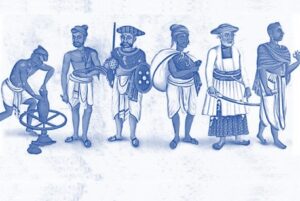

Character arrangement
- According to the ancient Dharma Sutras and Dharma Shastras, the Brahmins divided the society into 4 varnas: –
- The first of the four Hindu castes based on duties and rights of individuals the Brahman is a guide.
- A man or member of the Kshatriya class or warrior class
- The third main caste of traders and landlords in social hierarchy of Hindus
- Member of the fourth class in Hindu social hierarchy


Origin of characters
- According to the Brahmins, all the varnas originated from different parts of Brahma’s body.
- Based on this, the functions of that character were determined.
According to Brahmins
- Brahmins originated from the mouth of Brahma ji.
- Kshatriyas originated from their shoulders and arms.
- The origin of Vaishya is told from the thighs.
- The Shudras originated from the feet of Brahma ji.
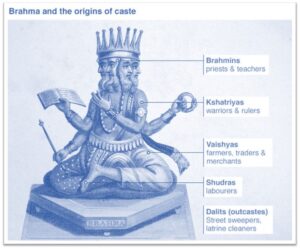

Other Categories
- Brahmins considered some people to be excluded from this varna system.
- According to him there were two types of karma: –
Sacred Deeds
- All the work that was done by the 4 classes of people was considered sacred deeds.
Corrupt deeds
- Apart from this, other tasks such as lifting dead bodies, performing funerals, cleaning the dirt, etc. were considered contaminated deeds.
- All such people who used to do this evil deed were declared untouchables.
Functions of different characters
According to this division, the work of all these was also divided.
The first of the four Hindu castes based on duties and rights of individuals the Brahman is a guide.
- Studying the Vedas, performing yagna and getting it done, asking for alms.
A man or member of the Kshatriya class or warrior class
- Rule, fight, judge, give charity, provide security to people, perform yajna, read Vedas, etc.
- Agriculture, animal husbandry, trade, reading the Vedas, performing yajna, donating etc.
- Serving all three characters
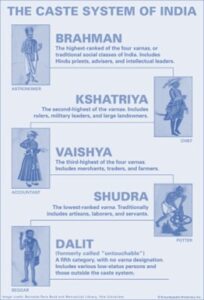

Ethnic system
- Over time, many such people came forward who could not fit into the varna system created by the Brahmins.
- In view of this situation, the Brahmins created the caste system.
- These castes were determined according to the work being done by the individuals.
- Over time, the number of these castes increased, and they were also determined according to birth
- Such as
- hunting
- Nishad (people living in the forest)
- potter
- Goldsmith
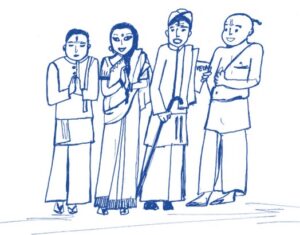

Characteristics of caste
- Caste is determined by birth.
- No person can leave his caste, but a person can be taken out of his caste.
- Caste also includes rules related to marriage.
- Such as
- Marrying in the same caste.
- Such as
- There were also rules for eating and distributing food based on caste.
- For example
- What kind of food can be eaten.
- With whom can you sit and eat?
- Castes are united in hierarchy.
- There are high and low castes in every caste.
- All castes are associated with a particular occupation.
- A person born in one caste can adopt the occupation of that caste only.
The status of castes in ancient society
- All things about castes were written in religious texts, but how much they were used in real society is not clear.
- Due to the caste system, some people benefited while many people also suffered from it, for example, the upper caste people benefited from this system while the lower caste people were exploited.
- Due to the strict rules of caste, it was very difficult for any person to change his position in the future.
- All the rules of caste were made on the basis that all those castes were separate from each other and could not mingle with each other.
- The caste system was like a ladder, that is, the order of every caste in the society was from top to bottom.
- Religiously, castes were based on purity and impure, some castes were considered pure, while some castes were considered impure.
- The castes which were considered pure had a high place in society while the castes considered unclean had a lower place in society.
Caste system in colonial period (1800 to 1947)
- To run the administration properly, the British tried to understand the caste system of India.
- Caste related data was collected through the census conducted in 1860.
- During the census conducted in 1901, data on caste hierarchy was collected.
- During this time many people applied and gave evidence to prove themselves to be of upper caste.
- Thus, due to keeping caste related information in writing, this system became more stringent.
- Based on these figures, the rights of the upper castes were recognized by the British Government, including land revenue rights.
- In this way, a clear distinction was made by the government between the upper and the lower castes.
- For all these reasons, the colonial period had a profound effect on the caste system.
Caste system after independence (after 1947)
- All citizens were treated as equal by the Constitution of India.
- Almost all the leaders involved in the freedom movement demanded the elimination of untouchability in the country.
- Efforts were made to promote lower caste people in the country and the upper caste people were also assured that there was no shortage of opportunities for AAP.
- Due to development and privatization in the country, many new businesses came which were different from the caste system, thus reducing caste inequality.
- Urbanization and urban order made it difficult to follow ethnic rules.
- The people of independent India were more impressed by the idea of giving importance based on merit rather than caste.
- But in some areas, such as villages, this system remained the same.
- It is not normal to marry from one caste to another and the caste rules are also strong in terms of food sharing rules.
- The influence of the caste system in politics led to the emergence of many caste-based parties and at the same time many candidates won based on ethnic support.
Tribal Community
- Tribal communities are the communities that have been residents of an area since a very old time.
- Tribal communities were those communities which did not follow any religion according to any religious text.
- They had no common type of state or political organization.
- Their communities were not rigidly divided into classes.
- There was no caste system among them.
- He was neither a Hindu nor a farmer.
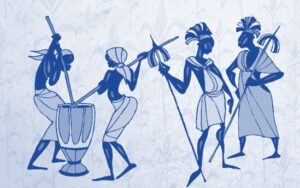

Classification of Tribal Communities
- Tribal communities are mainly divided into two parts: –
- Permanent Specialty
- Earned attributes.
Permanent Specialty
- It includes people who are mainly associated with tribes.
Residence
- About 85% of them live in central India, extending from Gujarat and Rajasthan in the west to Orissa and West Bengal in the east.
- The remaining 11% lives in the north-eastern states and the rest in other parts of the country
Language
- The languages of the tribal group are mainly divided into four parts.
- Indian Aryan family (1%)
- Dravidian family (80%)
- Austric
- Tibetan
Population
- The largest tribe by population has a population of about 70 lakhs and the smallest tribe, the Andaman Islanders, has a population of only around 100.
- According to the 2001 census, about 8.2% of the total population of India i.e., 8.4 crore people belong to the tribe.
- Some of the biggest tribes are Gond, Bhil, Santhal, Bodo and Munda
Earned attributes.
- It is determined mainly on the basis of livelihood and the extent of their inclusion in Hindu society.
Based on livelihood
- Based on livelihood, the tribes are divided into categories like fishermen, food collectors, hawkers, jhum cultivators etc.
Based on their inclusion in Hindu society
- Based on their inclusion in Hindu society, it is seen what their position in Hindu society is because there are different ideologies about Hindu society among the tribes, some have a positive inclination towards Hindutva, while some tribes oppose Hindutva.
Mainstream people and tribes
- Exploitation by moneylenders
- Non-tribal people occupying their space.
- Inability to access forests due to the forest conservation policy of the governments
- Displacement due to mining operations
- Increasing influence of other people
Development of Tribal Groups
- In the 1940s, two different ideologies emerged regarding the development of tribal groups: separation and integration.
- Ideology of separation
- Those who support the ideology of segregation said tribal people need to be protected from traders, moneylenders, and people of other religions as it seeks to end their existence and make them landless labourers.
- Ideology of integration
- Those who support the ideology of integration said that all these tribal people should be treated like other castes and given equal opportunities for education, trade and development.
National Development vs Tribal Development
- The development of the nation has been the biggest cause of destruction for the tribes.
- From the time of Nehru, the construction of big dams and development works started in the country.
- Under this process, forests were exploited, large dams were built, due to which tribal groups who were dependent on forests had to be displaced from their area.
- Due to this displacement, these communities disintegrated and became a minority in their area.
- These tribal groups have paid the biggest price for development in the country.
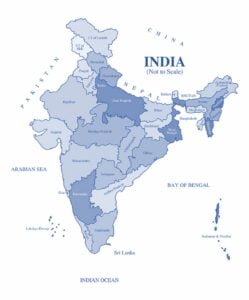

Contemporary Tribal Identity (present era)
- Creation of states like Chhattisgarh and Jharkhand
- Many special rights have been granted to tribes all over India.
- Increase in cultural importance.
- Development of educated class
- Control of forest resources
Family
Family
- The family is one of the important institutions of society.
- In Sanskrit texts, the family is called a clan.
Family Characteristics
- Sharing of resources among all members of the family
- Stay together.
- Cooperation
- Use of available resources in the family
Family Type
Original Family
- The basic family consists of only parents and their children.
Extended family
- Extended family in an extended family, people of two or more generations live together. It is also called joint family.
We hope that class 12 Sociology Book 1 Chapter 3 (Social Institutions: Continuity and Change) notes in English helped you. If you have any query about class 12 Sociology Book 1 Chapter 3 (Social Institutions: Continuity and Change) notes in Hindi or about any other notes of class 12 Sociology in English, so you can comment below. We will reach you as soon as possible…


